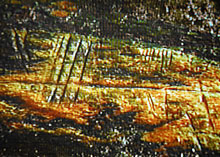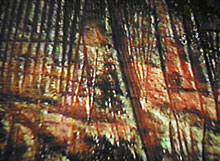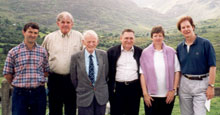 |
| Irish petroglyph detail.
Compare to the West Virginia petroglyph detail at
the top left of this page. |
For the first time
it is possible to say with some degree of certainty
that there is real evidence of pre-Columbian visitors
to the North American continent. In fact, you could
say it is carved in stone. Twenty years of research
leads to the conclusion that the same disciplines and
tools were employed to create Ogam glyphs and Christian
symbols (Chi-Rho) on rock faces in both southern West
Virginia and southern Ireland.
In 1981, archaeologist Robert
L. Pyle of Morgantown, West Virginia began exploring
the mountains of southern part of the state studying
petroglyphs (markings on stone) that at first glance
resembled archaic runes and were different from traditional
ancient American rock carvings. His archaeological research
focused on petroglyph
sites in Wyoming County, West Virginia, and Manchester,
Kentucky. Research indicated the markings were an ancient
alphabet known as Ogam (or Ogham), found in the British
Isles, especially Ireland, Scotland, and Wales. (The
petroglyphs in West Virginia and Kentucky exhibit what
is known in Europe as "stem type Ogam.") The
markings were considered in connection with the tradition
of St. Brendan's voyages to this continent in the 6th
century.
 |
| Another view of the recently
discovered Irish petroglyph. Note the vertical Ogam
markings. |
Dr. William Grant,
Edinburgh University, Scotland, and Dr. John Grant,
Oakland, Maryland, both Celtic linguists/scholars, participated
in Pyle's Ogam research in southern West Virginia and
endorsed the West Virginia petroglyphs as authentic
archaic Ogam. The Grants were former students at the
Catholic University in Washington, DC, under the direction
of Dr. Robert Meyer, Celtic professor and linguist for
33 years.
In 1998 and 2000,
Pyle traveled to Ireland to investigate Ogam markings.
In 2000 Dr. William Grant invited Pyle to participate
in a research team that examined the first known Irish
Ogam petroglyph panel, located in the remote and rugged
mountains of southern Ireland. Ogam has commonly been
found on corner edges of tombstones, not on rock formations.
The unique Irish petroglyph panel turned out to be larger
and more complex, yet the markings were virtually identical
to the West Virginia and Kentucky petroglyphs.
 |
| Stephen O'Shea, Earl E. Hill,
Dr. William Grant, Robert L. Pyle, Breda O'Shea,
and Mike Baker. Photo taken in southern Ireland. |
The expedition
was mounted by Dr. William Grant and led by Stephen
O'Shea. Michael Baker, a film producer, and crew documented
the entire expedition. Five hours of strenuous climbing
led to the petroglyph location in a "wedge tomb"
where Pyle immediately recognized the similarities between
Irish and American petroglyphs. The panel is 8 feet
high and 20 feet long, and the markings are textbook
examples of the alphabet known as Ogam. Significant
features include: (1) the Irish Ogam is identical in
form to that found in West Virginia and Manchester,
Kentucky; (2) it is identical in form to that found
in the Book of Balleymote, which is located in the Royal
Irish Academy in Dublin; (3) the same types of symbol
are identified on artifacts and cliff carvings.
Robert
L. Pyle, Archaeologist
Resume and Qualifications
Comprehensive information
about the petroglyph studies appears in Robert L. Pyle's
book "All That Remains: A West Virginia archaeologist's
discoveries, 2nd edition." It can be ordered for
$25 total (includes shipping) from Robert L. Pyle, 1964B
Negley Avenue, Morgantown, W.Va. 26505. www.AncientRemains.com
|
We
Need Your Help!
Our work has just begun and funding is needed
for preservation, historical research, museum
exhibits, and preparation of educational documentaries.
Donations
can be sent to:
WV Petroglyph Trust
I964 B Negley Avenue Morgantown, WV 26505
|
Copyright 2002 by Robert L. Pyle
|

